
|
Burro
Schmidt's
Tunnel
Update |
|
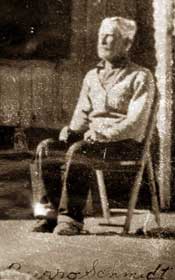
Burro
Schmidt's "Famous Tunnel" now has a group of
"friends" trying to preserve and protect the
site. Click
the photo to visit their Website. |
|
|
TIME
TO
RENEW!
The
birth of a new year is also the death of California campfire
permits issued in 2004. Visit your local land management agency (BLM,
NPS, USFS or State Parks) to renew your campfire permit for the
2005 calendar year.
|
|
|
Click on
the photo below to read more about Cerro Gordo.
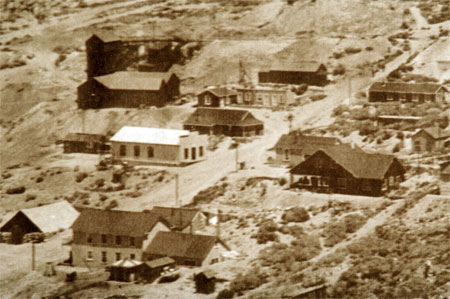
|
|
|
|
|
|
Don't have a 4X and want to
visit historic sites in Eastern California?
Capture the spirit of the past as it comes alive with true tales of pioneer families, prospectors, muleskinners, hero's and gunslingers. Listen to legends of lost gold, found wealth and superstitions.
Journey back in time with Terri Geissinger - Historian, Interpreter and Guide

Click on Terri's yellow van for Terri's
Ghost Town Tours or
contact Terri by clicking here:

|
|
|
|

The
Panamint Breeze
is a new publication highlighting the history and legends
California and Nevada.
Click
on the logo to
request subscription information. |
|
|
Buffalo
Gnats Plague The Mining Camp Trails
by
Cecile Page Vargo
|
|
It all began on a spring day in 1875, as Victor Beaudry, rode his
horse along the familiar route from
Cerro Gordo
to Darwin, now better known as California State Highway 190. Perhaps it was a day
much like the one experienced most recently by our group of Los Angeles
Pierce
College
photojournalism students, with temperatures finally warming to the very
dry 80's after a long wet winter. Owens lake would not have been bled
dry by thirsty neighbors to the south, and strong air currents would
have created gentle waves in the great inland sea instead of hazardous
dust. The nearby mountains, clearly towering amongst the bright blue
sky, may have also reflected in that great inland sea. The silver
bullion king may also have been
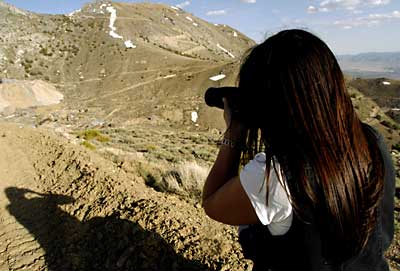 |
| Free
from the threat of outlaw buffalo gnats, Pierce College
photojournalism student Maria Zajacz photographs present day
Cerro Gordo. |
enjoying the prolific wildflowers before
he was surprised by a group of Mexicans who demanded, "Dismount,
and write an order. Beaudry orders good as currency," after he had
tried to persuade them that he actually had very little money on his
person. Seeing no reason to argue with them, he wrote the orders as they
requested, an amount he considered reasonable all and in all
considering, and then was
sent on his way. The Mexican bandits disappeared into the nearby hills.
A stagecoach heading to Panamint
City
from Indian Wells, noted a few days later that a group of Mexicans
passed them by.
Reign of Terror Begins
The weather may or may not have been as glorious as described in
the previous paragraph, but
the days that followed were reportedly heavy with rains, and flooding.
Trade along the
Owens
Valley
slowed, and the stagecoaches had a tough time going along the muddy
routes. Between
Independence
and Lone Pine one particularly large mud hole nearly swallowed up
several teams that attempted to pass through. By late March, however,
the bandit Cleovaro Chavez was raiding the station at Little Lake. He
and his band of man tied up the station proprietor and three others,
then took off with four stage-line horses, supplies, and valuables. Not
long after this, the
Boron
Lake
station keeper was kidnapped and eleven stage horses were stolen. This
station keeper was found hours after the event, tied up and abandoned.
He told stories of Chavez practicing his gun skills by shooting off the
neck of a bottle. At still another station it was said that Chavez stole
more food and supplies. Once again he showed off his shooting skills, by
aiming at and shooting the head of an unsuspecting chicken from 300
yards away. The reign of terror by Chavez and others like him had begun.
The bandits were dubbed "Buffalo Gnats" by the boys in blue
down in
Independence
who tried to capture them, as they were as elusive and pesky as the
black fly that went by the same name.
 |
| The buffalo
gnat (family Simuliidae), sometimes referred to as the black fly, has historically been a
serious pest, causing much
economic and physical damage. |
One Indian War veteran was captured by two bandits, he described
as an old man and a young one, both Mexicans, who asked him if he would
forget the whole thing if they were to release him. Barton McGee
honestly replied that he would kill them at the first chance.
Fortunately, for McGee, his captors were afraid to execute him. In the
dark of night he was able to loosen his ties and proceeded to follow
through on his threat to kill them, but was caught in the act, and tied
up once again. McGee was held captive for a total of 28 hours, then
thrown barefoot and hatless on a bare, bridles mule. As he was turned
loose, McGee slapped the mule with his hands and headed for the mining
camp of Coso. In Coso he obtained proper supplies and headed back to the
scene of the crime. The next time he was seen he was on his own horse,
which had been stolen by the bandits, replying, "Well, I got my
horse." Later at a inquest for one dead and one runaway bandit, the
Coroner's jury reported that the dead man had been "buried
according to Hoyle."
Read
More
|
|
Meet
Bwana Dusty Darwin
by
Cecile
Page Vargo
|
|
The day after our latest visit to Cerro Gordo
we were given a
six week old short white haired, blue eyed, Bwana Dusty weather
forecasting device. He’s a bit young to detect outdoor weather,
but he’s doing a good job of detecting the weather indoors. My
little three pound Bwana Dusty Darwin F. Cat, is sleeping on a
comforter on the rocker in my office. From the way he is laying on
his back, I can tell he's detecting the weather to be rather warm.
Since I haven't been in here much today, and it has actually been
cooler outside (in the 80's as opposed to the 90's of the past few
days) I don't have the air on and Bwana Dusty Darwin, who is
learning to answer to the name
"Darwin",
is correctly detecting that it is hot. The thermometer on the wall
above my computer is saying 85 degrees.
|
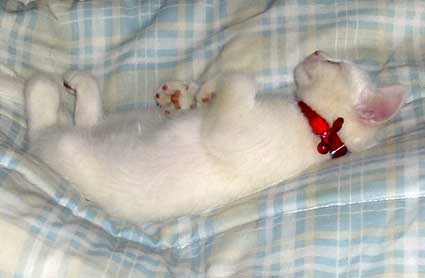
|
| Our
little Bwana Dusty Darwin F. Cat contemplates a forecast. |
Downloaded from the original unofficial Darwin
website, thanks to Dezdan, is the manual to the
Bwana DustyTM
Weather Forecasting Device. It remains to be seen if my Bwana Dusty
Darwin F. Cat will live up to his name. We should know in about a
year when he reaches 10 pounds.
|
from
Irv's unofficial Darwin
webite
http://members.aol.com/dierdorff/darwin/index.html
|
|
Bwana
Dusty as weather-forecasting device
If
the phone lines are down (which happens every second
thunderstorm or so), you can't glean local weather
conditions from the Internet. (No, cell phones don't work in
Darwin; stop trying to second guess me.)
A satellite dish might be
able to pick up some semblance of local weather, but we
don't have one, so we can't. You can't receive local radio
stations out of Bishop or Lone Pine unless you drive to the
top of a hill, five or so miles away. You can get a
five-word weather report every hour or so on Thunder Country
FM out of Ridgecrest, but it's generic and useless. So, in a pinch we've devised
a way to use Bwana Dusty as a weather-forecasting aid. If
you don't have Bwana Dusty around (which chances are, you
won't--because she's our cat), you can use a small pet of
your choice.
The emphasis here is on small. Anything too big, say German
Shepard size, would interfere with forecast accuracy.
Anything too small--say, gerbil size--would have an opposite
deleterious affect. If you don't have a suitably sized
animal, we have provided a likeness of Bwana to the left.
Simply download the image, cut it out, and using heavy-duty
glue of some sort, paste the image artistically onto a
smoothish rock weighing about seven to 10 pounds. Next
attach a six-inch piece of yarn or string to the rock with
duct tape. Now you have a Bwana Dusty Weather RockTM.
|
|
Desert
humor is often an exaggeration. Never subject your living
"Bwana Dusty" to dangerous situations. Instead,
use either the
Bwana Dusty Weather RockTM
or Mojave
Desert wind sock described above.
|
Read
More
|
|
2005
Tour Information |
|
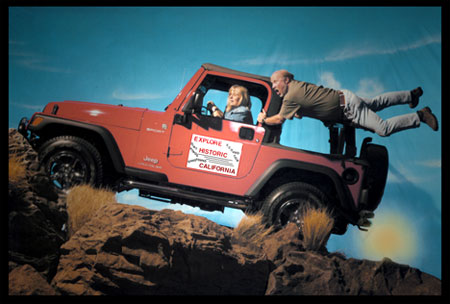
We're still in the process of
finalizing details for our tour insurance. We hope to be back on the
trail for our Fall, 2005 tours.
Please contact us at info@explorehistoricalif.com
for tentative dates or to be put on our interest list.
|
|
Explore Historic California! |
|
Not too many years ago, the family station wagon was the
magic carpet to adventure. Today, that family station wagon is likely to
be a four wheel drive sport utility vehicle or pick up truck. SUV's and
other 4x4's are one of the best selling classes of vehicles. Ironically,
industry statistics show that once purchased, few owners will dare to
drive their vehicles off the paved highway. Click your mouse through our
website and enjoy our armchair adventures and the histories behind them.
If you are interested in taking one of our guided tours with your
vehicle, please visit our ECOLOGICAL 4-WHEELING ADVENTURES.
Several years ago, we bought our first SUV. We went to a one-night class
at a local community college entitled "How to 4-Wheel Drive" by Harry Lewellyn.
The following weekend we attended the hands-on day tour. We liked what we were
doing so much that we began going out nearly every weekend and learned how to
negotiate a variety of dirt roads. Our spare time was spent doing research on
the history and ecology of our favorite areas. A one-day outing turned into 16
years of leading others on mini-vacations throughout Southern California and the
Owens Valley.
Our 4WD outings involve driving on easy to moderate dirt roads and are
ideally suited to novice and intermediate level drivers. All tours are suitable
for stock vehicles in good condition, although some tours do have vehicle size
restrictions.
Our tours are
operated under permits issued by the Bureau of Land Management, U.S.
Forest Service, and other authorities.
We share our knowledge of the backcountry over the CB radio with our
guests. We frequently stop to explore mining areas, old and new, and ponder the
rocks, plants and animals we may encounter. We'll occasionally visit an old
cabin or deserted mountain lookout.
California has a fascinating history, from geologic unrest and
prehistoric petroglyph scribes to the "Radium Queen of the Mojave" and the
"Human Mole of Black Mountain." Load up your 4X, fasten your seatbelts and get
ready to explore historic California.
Roger, Cecile and Marty |
|
|

